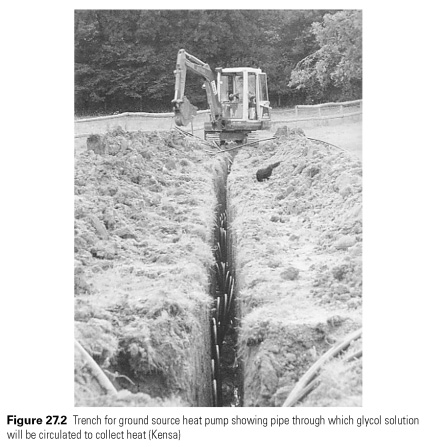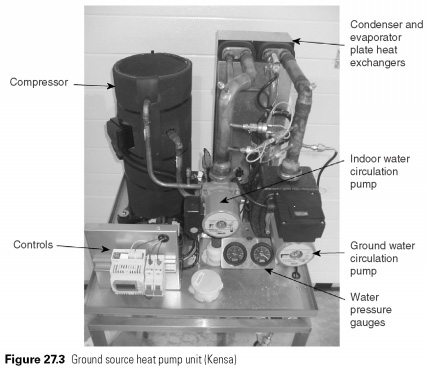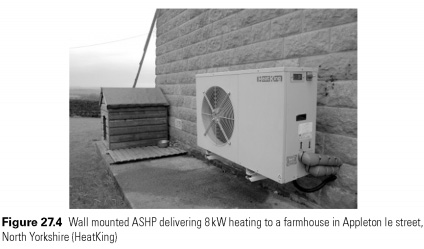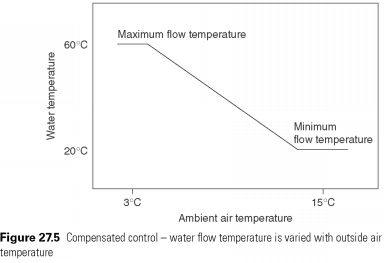Dedicated heat pumps
Air conditioning is not considered as a mandatory requirement for the majority of UK residential and light commercial applications, but, heating, certainly is. Specially built for HP has the function of cooling, or even if he does, he is optimized for heating. The British market for this type of equipment in its infancy, but also in many other European countries, particularly in Sweden, Germany and Switzerland, HPP installed as a cost-effective substitute for the boilers. HP type and performance is characterized by the nature of the source, which is the medium, from which the heat is extracted by the evaporator, and a shell, i.e. the distribution of heat in a building.
The two main sources of geothermal energy, which is sometimes known as geothermal and air. Water is probably the best source, if available, and comes under the General heading of underground sources. Some, particularly the successful HPP use of the nearby lakes as a source. Water (preferably containing some glycol to prevent freezing) is distributed through the coil plunged into the lake, and he takes the heat so that it arrives at the evaporator in HP at the temperature close to the lake temperature.
The advantage of water as a source is that the temperature is stable enough and, as a rule, higher than 10C. the water in the Lake or ground water may be submitted directly to the evaporator, but the effect of pollutants should then be considered. Geological conditions may allow drilling for water source, and to return to the groundwater, but, again, of polluting substances in water can cause problems. With any water sources, care must be taken to observe the local regulations.
Below a certain depth of ground temperatures remain relatively stable and there are several ways to extract heat from the ground. The ground source heat pump (GSHP) is a typical source of the temperature 5-10C and the most frequently cited technology, when the heating systems are considered. One way to extract the heat to circulate a glycol solution through plastic pipes were laid in the trench (Fig. 27.2), and on earth source, he behaves in a very similar way to the water source.

An alternative method that can be used where space is limited, drilling holes and to circulate the coolant (again in a closed loop) in sufficient depth to obtain the necessary heat. Drilling depth of 50 m up and are typical, but is still in a region where the temperature of the soil are primarily determined by the temperature of the air. GSHPs capture solar heat stored in the ground. It is also possible to circulate refrigerant directly inserting the copper tube in drilling. This eliminates one of the heat barriers, but increases the refrigerant charge and there is always the danger of underground leakage of the refrigerant, which can be expensive to fix. Factory-assembled HP unit itself is quite compact and contains a complete refrigeration circuit and pumps for circulation of cold and warm secondary fluid Fig. 27.3 . HFC refrigerants are used, basically, and there is an assumption use propane, R290, in a compact outdoor unit. Please note that the compressor and discharge piping hot isolated to minimize heat loss to the atmosphere.

In the UK, the air is clear and very suitable source of heat. Air temperature in the range of 5-15C the majority of the heating season, higher than when using groundwater sources for most of the year, resulting in excellent performance. Without drilling or tranches of the installed cost of such units tend to be much smaller, and there is also much less disruption. In ASHP in Fig. 27.4 contains the complete refrigeration circuit and is similar in this respect GSHP, but with air coil evaporator and fan instead of a plate heat exchanger and pump water.

However, there are some drawbacks with air source. Outdoor temperature change significantly affects the capacity and efficiency. In particular, in the conditions of low ambient air temperatures lead to reduced performance and adds to the problem of ice formation on the open spiral. Defrosting can be done by reversing valve temporarily delivery of hot gas in the outdoor coil, although this may have an undesirable effect suddenly cooling hot water! Another method is to redirect selected discharge gas for the evaporator with the help of the hot gas bypass valve. While the duration of the very low temperature of the outside air conditions can be relatively short, their arrival coincides with the most acute need for heating, and it is therefore very important to ASHP can handle. Sufficient capacity requires more units than would be required for ground-source, or alternatively use an additional source of heat during cold spells. This is sometimes called a back-up heating.
The temperature to which heat shall be raised or raised depending on the required temperature in the point of use and distribution system. Space heating can be delivered in less than 25C if the air directly heated, but the need to go in the room units small requirements to the relatively high temperature of condensation. The refrigerant / air heat exchangers require a larger temperature difference than the liquid refrigerant heat exchangers.
One of the most effective ways of delivering space heating floors, water distribution system. It consists of a plastic coils, embedded in a solid floor, above the layer of heat insulation. With this system, water can be distributed at a relatively low temperature, say, 35-40C, provided that there is enough surface of the floor are available. Under-floor is less suitable for buildings with suspended floors and is almost exclusively used in the construction of new nuclear power plants. Wall radiators lead to lower-than-Cops floor with coils, because of the higher temperature of the water is not required.
Provision of hot water (DHW) in addition to heating the premises requires management system so that HP can deliver a lower temperature heat for space heating after DHW demand is met. In addition, the top-up of electrical submersible heaters or built-in heater to bring the temperature of the water up to 60C.
It can be seen that there are a number of possible configuration HP and every application requires careful consideration of the source, sink and nature of the use. Performance is due primarily to the efficiency of the heat source and heat sink, and not rated capacity of the unit. There is a danger of decrease in costs by reducing the size of the collector, or by installing the lack of heating surfaces in the building. Both lead to excessive temperature rise and lowering of capacity and COP. Insulation of the building should be considered first design of the heating system. It is usually cheaper to bring to the level of isolation, the installation of additional capacity HP - and this is quite apart from the current expenditures considerations.

Rating points for hydropower plants are in the European Standard 14511, 2004, but the actual operating conditions can vary significantly throughout most of the year. Water consumption temperature reduction, sometimes referred to as compensation management (see Fig. 27.5), brings significant performance benefits during periods of lower heating load. To identify the most important parameter of the concept of seasonal COP or a MINSTREL, sometimes called Seasonal performance factor (SPF) is introduced. It defines the ratio of annual heat output to the yearly output of the input signal, with the local nature of weather data to establish the heating load, and in the case of air source, HP performance. This is an option that should be used in the evaluation of current expenditure advantages of HP compared with traditional heating methods. Example of HP advantages in terms of the use of fossil fuels, carbon emissions, and operating costs, are listed in Section 30.4.
Gas engine HPP bonus offer additional heat from the engine coolant at a higher temperature than the refrigerant in the condenser. Open the compressor is required and after the installation of static, and required to run on a relatively long time without attention, the drive Assembly must be strong enough to withstand the additional vibration and must be separated from the rest of the circuit. Gas engine-driven VRF systems begin to appear in commercial applications...
|




